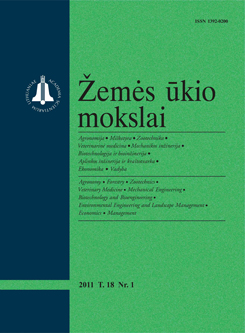Žemės ūkio mokslai / Agricultural Sciences
WHAT?
 ISSN 1392-0200 |
2004 m. Nr. 2 Labiausiai paplitusios patogeninės bakterijos kiaulėse ir jų atsparumas antimikrobinėms medžiagoms
Pathological material from pigs
was investigated in the Veterinary Institute of Lithuanian Veterinary Academy
and National Veterinary Laboratory during a 5-year period. Pathological
material was investigated under suspicion of infections caused by pathogenic
bacteria with the aim to isolate them and to determine their resistance to
antimicrobials. In Lithuanian pig farms, among pathogenic and opportunistic
bacteria most frequently E. coli and Salmonella spp. 176 strains of E. coli and
122 strains of Salmonella were isolated. The most common serotypes of E.coli were 08:K87, 0141:K85, and
0149:K91. Most of them contained fimbrial antigens F4, F5 or F6. S.
Choleraesuis (79%) was the most common serovar among Salmonella. The highly
pathogenic S. Enteritidis and S. Typhimurium were infrequent (respectively 3.3%
and 2.5%).The HAP group (Haemophilus,
Actinobacillus and Pasteurella) bacteria were also rather widespread: 84
strains of this group were isolated. The most frequent pathogens were
Actinobacillus pleuropneumoniae, Haemophilus parasuis and Pasteurella
multocida.The bacteria
isolated from pigs were comparatively resistant to antimicrobials. E. coli and
Salmonella spp. were most susceptible to polymyxin B and fluoroquinolones. The
resistance to other antimicrobials was higher, especially to
lincomycin-spectinomycin and aminoglycosides. 25% of
staphylococci were resistant to penicillin, and 50% of streptococci were
resistant to gentamicin. Bacteria of the HAP group were susceptible to many
antimicrobials. All investigated Pasteurella multocida were
tetracycline-sensitive, whereas Haemophilus and Actinobacillus spp. were
susceptible to chloramphenicol, ceftiofur and polymyxin B.
Raktažodžiai: antimicrobials, E. coli, HAP, resistance, Salmonella |
Numeriai:
2012 - T.19 Nr.1 2011 - T.18 Nr.1, Nr.2, Nr.3, Nr.4 2010 - T.17 Nr.1-2, Nr.3-4 2009 - T.16 Nr.1-2, Nr.3-4 2008 - T.15 Nr.1, Nr.2, Nr.3, Nr.4 2007 - T.14 Nr.1, Nr.2, Nr.3, Nr.4, Nr.Priedas 2006 Nr.1, Nr.1.Priedas, Nr.2, Nr.3, Nr.4 2005 Nr.1, Nr.2, Nr.3, Nr.4 2004 Nr.1, Nr.2, Nr.3, Nr.4 2003 Nr.1, Nr.2, Nr.3, Nr.4 2002 Nr.1, Nr.2, Nr.3, Nr.4 2001 Nr.1, Nr.2, Nr.3, Nr.4 |